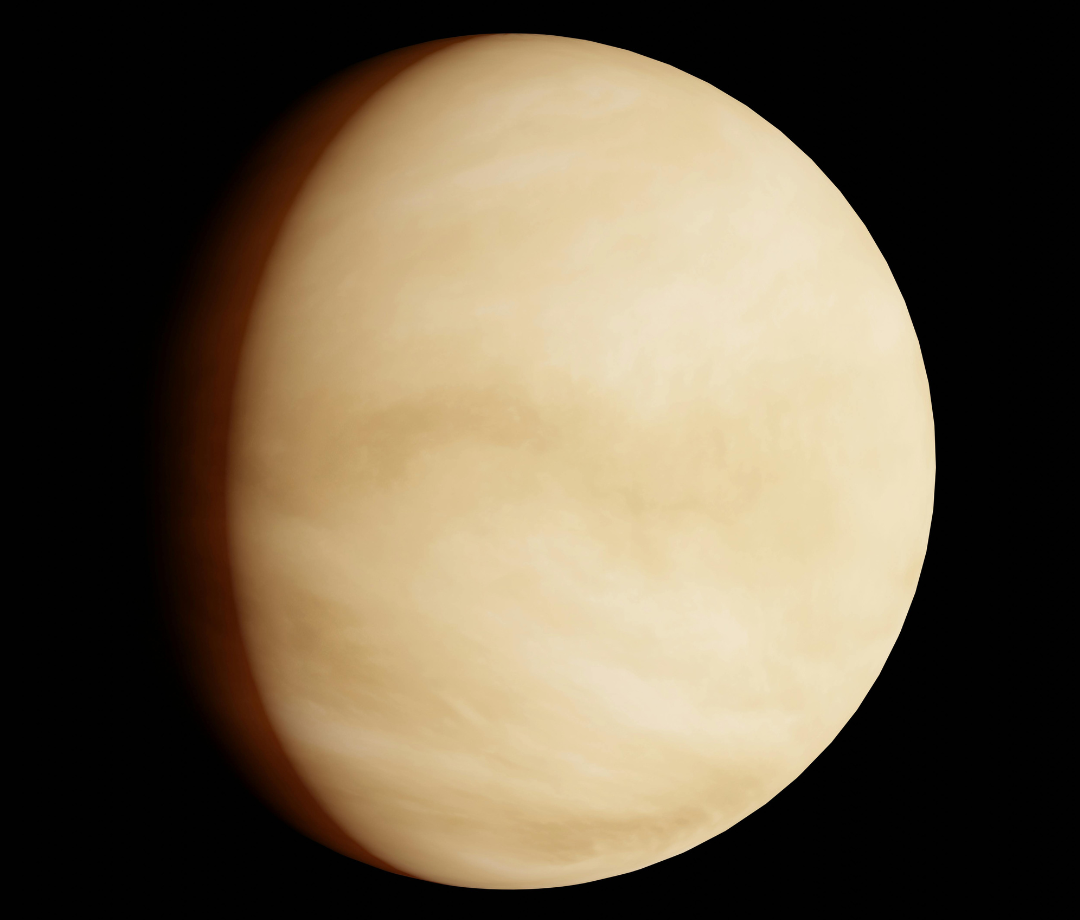What Is Venus?
Venus is the second planet from the sun within our solar system. It is often referred to as Earth’s “sister planet” due to the numerous similarities between the two planets. It averages being around 0.72 AU (about 72% as far from the sun as Earth), while being about 82% as massive as the Earth, with about 86% as much volume, and a radius of about 95% that of Earth. It is the most similar to Earth according to each of these numbers, giving plenty of truth to this name. Due to its proximity to Earth and respectable size compared to the other rocky planets, it is the brightest object in the night sky except for the moon. Venus is also the first star-like figure seen after sunset and the last to disappear from visibility before sunrise, giving it the nicknames “morning star” and “evening star”. It is the 6th largest planet in the solar system, being larger than both Mars and Mercury, but smaller than Earth and the four gas giants: Jupiter, Saturn, Uranus and Neptune.
Venus is known for its similarities to Earth, thick atmosphere made up of carbon dioxide, burning hot temperatures, and retrograde orbit. It should also be noted that Venus is considered to be “upside down”, as it spins in the opposite direction to the other planets.
How Long Are Days And Years On Venus?
A year on Venus is approximately 225 days long. How long a “day” is on Venus is has two different answers, depending on how one defines a “day”. A “solar day”, or the amount of time it takes the sun to appear in the same part of the sky, is 117 Earth days, while a sidereal day is the time it takes to rotate on its own axis, which is 243 Earth days, which is longer than its year. This means that even though it takes 243 days to rotate, a “day” lasts 117 Earth days.
What Is The Atmosphere Of Venus Like?
The atmosphere of Venus is very thick. It is made up of over 96% Carbon Dioxide, with most of the rest being Nitrogen and trace amounts of other gases. Venus’ atmosphere is 92 times as massive as Earth’s atmosphere and is responsible for the pressure on the surface of the planet being 93 times as great as Earth’s. The planet is also covered by clouds made of sulfuric acid.
It has been speculated that Venus’ atmosphere was once, billions of years ago, similar to that of Earth’s. However, today it is a much thicker, more dangerous version than it was back then. Although the reason for a possible change is unknown, it is speculated that large amounts of volcanic activity were at least one of the factors involved in the change.
How Warm Is Venus?
Venus is extremely hot, even hotter than Mercury during the day. Temperatures on Venus can reach over 480 °C (896 °F). It’s so hot here that 440 °C (824°F) is considered cold. Unlike Mercury, Venus, due to its heavy atmosphere trapping heat closer to the surface, the planet remains hot during the night.
About 108 million km (67 million miles) from the sun, Venus is slightly closer to the sun than Earth, which also helps contribute to this heat slightly.
How Windy Is Venus?
The amount of wind received on Venus varies a lot, depending on how high in the atmosphere you are. Near the surface, the wind rarely reaches double-digit speeds when measured in km/h, although the thick atmosphere makes it feel much stronger. Much higher up in the atmosphere, winds can reach over 350 km/h (217 mph). This makes it very difficult for space programs such as NASA to properly land rovers and other machines on the surface of the planet.
How Rainy Is Venus?
This is a more complex answer than you are likely to think. It rains relatively frequently on Venus, although that rain is made up of sulfuric acid. However, since Venus, even on a cold day, is hot enough to melt lead, even this rain evaporates before it even reaches the surface of the planet.
Does Venus Have Storms?
Venus does have storm-like conditions, especially in the upper atmosphere due to the insanely high winds and dangerous rain. Even on the ground, the very thick atmosphere and heavy pressure as a result of that atmosphere, it will constantly feel like a storm is occurring.
One thing that is hotly debated is whether or not lightning and thunderstorms exist within the planet’s atmosphere. Lightning has never been observed on Venus by any craft, but there have been some phenomena detected, such as whistler waves, that could be explained by the presence of lightning on the planet. At the moment, there are many scientists on either side of the debate.
Can Venus Support Life?
Life as we know it can not exist on Venus. The high temperature, as well as the lack of oxygen and water, make life as we are familiar with it impossible on this planet.
However, it is possible that extremophiles could live here. While even Earth’s most resilient extremophiles couldn’t exist on Venus’ surface, it’s not impossible. Also, temperatures within the clouds near the top of the atmosphere can be as low as 30 °C (86 °F), which is something that many forms of microscopic life on Earth can survive in. So far, although no life has conclusively been found on the planet, and the dangerous conditions on the planet make it difficult for probes to last long enough to gather meaningful data, it is possible that some form of life could exist on the planet, although it would likely be very different than any life on Earth.
Can Venus Be Terraformed?
Terraforming refers to the process of making a planet more Earth-like. Doing this with Venus would be extremely challenging, as it would involve removing the heavy atmosphere instead of adding to it. Carl Sagan, who originally made a plan to terraform the planet in 1961, later spoke out saying that the plan he made would not be possible due to his underestimating how thick the atmosphere was. Several methods, including adding microscopic life forms suited for the conditions that can transform it, as well as removing the atmosphere directly, would likely be needed. This would be very expensive, take hundreds or even thousands of years, and would not have a guarantee of working. For that reason, it is unlikely that there will be any attempt to terraform the planet, at least within our lifetime.



